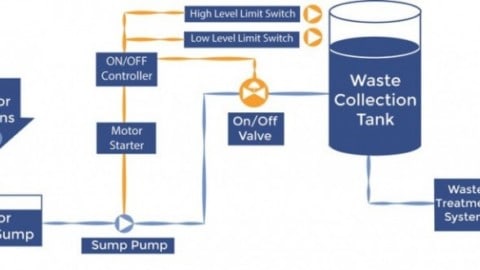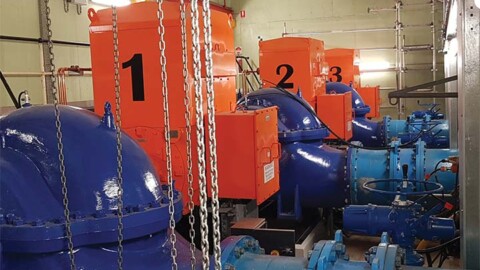Despite being an important piece of equipment connecting the pump and the motor, coupling selection is often underestimated, and proper procedure for installation and alignment of the coupling is regularly overlooked. Correct coupling selection is crucial to ensure reliable performance, ease of maintenance and efficient power transmission, while incorrect installation and alignment can lead to premature wear and failure, and damage to the pump and/or motor. Couplings are classed as either rigid or flexible types. Here, we look at types of flexible coupling and applications where they are best suited.

Most flexible couplings consist of two flanges or hubs – that attach to the pump and motor shaft being coupled – and a connecting element that may be metallic (e.g. like in disc couplings), a sleeve constructed from elastomeric material (e.g. EPDM rubber, neoprene, Hytrel or urethane), or mechanical (e.g. u-joint or gear coupling).
The basic function of a coupling is to transmit power, accommodate misalignment and compensate for axial movement, and sometimes it is expected to absorb shock or vibration.
There are four basic conditions of shaft misalignment or movement that will help determine the right coupling:
• Parallel misalignment – this occurs when the pump and motor shafts don’t share the same axis of rotation, with their end faces possibly being parallel while the centre axes are laterally displaced
• Angular misalignment – this occurs when the pump and motor shafts are neither coaxial or parallel, with the angle of misalignment possible symmetrical or asymmetrical
• End float – this occur when either or both the pump and motor shafts show axial movement, moving in and out
• Torsional flexibility – this is the torsional movement in place perpendicular to the shaft axis, and is typically caused by shock or vibration
Flexible couplings are designed to handle parallel and angular misalignment, and couplings with four-way flexibility can also accommodate end float and torsional movement.
Classifying flexible couplings
Flexible couplings are commonly classified based on them falling into one or more of the following groups:
• General purpose/special purpose (high performance)
• Lubricated/non-lubricated (dry)
• Mechanical or metallic/elastomeric
• Low speed/high speed
General purpose couplings are generally classified by speed and size, for example a coupling connected to a rotating machine that operates under 100HP is classed as small (sometimes referred to as low); between 100HP and 1,000HP is classed as medium; and over 1,000HP is classed as critical so these couplings are often considered to be special purpose or high performance.
Types of couplings that fall into this classification include synthetic gear, pin and bush, jaw/spider and tire (urethane or corded). Special purpose, or high performance, couplings perform the same functions as general purpose couplings but have been designed for applications with higher speeds and horsepower.
Coupling types that can be designed for special purpose are gear, disc or diaphragm, and usually use a spacer between shafts. Gear couplings – which have a mechanical element – usually require constant lubrication, while metallic element types such as disc or diaphragm couplings do not require lubrication.
Elastomeric couplings for general purpose
Elastomeric couplings are limited to general purpose pump applications below 100HP. In these couplings, the elastomer is placed in shear or compression and their ability to compensate for shaft misalignment comes from the flexure and/or displacement of the elastomeric element.
They require no lubrication, and consist of two hubs separated and connected by the elastomeric element made from natural rubber, neoprene, nitrile, urethane, Hytrel, or impregnated cloths and fibers.
In shear type couplings, the elastomer can be bonded, clamped or fitted to matching sections of the hubs. These couplings are also known as four-way flexible couplings as the elastomeric element is able to deform or stretch, displacing under a load.
They are also able to compress easily and stretch to handle end float. The level of torsional flexibility that elastomeric couplings in shear have, dampens the amplitude of vibrations, isolating one shaft from the effects of the other, and the energy absorbed during shock loads is used to wind the elastomer in a twisting action.
Under excessive shock, they will fail and disconnect the pump from the motor to protect it. In contrast, compression type couplings usually connect the components with projecting pins, bolts or lugs.
They don’t have the same amount of misalignment capacity or axial or torsional dampening capabilities as shear couplings but they do provide dampening to some extent.
There are three basic types of elastomeric coupling: tire, sleeve and jaw. Tire and sleeve types operate in shear to absorb shock and protect the equipment, and torsional flexibility allows them to dampen the amplitude of vibrations, isolating the motor and pump shafts from the effects of each other.
The elastomer essentially absorbs the energy generated during shock loads using a twisting action. A major benefit of these types of coupling is that they are designed to fail under excessive shock loads, disconnecting the pump from the motor to protect the pump if a lockup or other condition were to occur.
However, depending on the brand and the environment, elastomers in sleeve couplings can degrade when there are excessive changes in temperature and chemical exposure.
Tire couplings are popular for use on continuous-duty ANSI pumps in a variety of applications where there is minimal vibration, as well as applications that require variable flow rates.
This coupling type acts as a dampener and handles vibration more consistently than other types. A major advantage of tire coupling is that they can easily be replaced without having to move the pump and motor.
Special purpose couplings for high speed, high torque applications
While elastomeric couplings are good for lower HP applications, they are unable to be used for applications that require transmission of higher torques and speeds.
In such applications, special purpose or high performance couplings that are more torsionally rigid offer advantages. However, these gains do lower their torsional dampening so due to the stiffer design, more vibration will be transmitted to the pump.
Gear couplings are the most commonly used type of coupling in applications above 100HP in both high-speed, high-horsepower and high-torque, low-speed applications as they work well in applications that require torsional rigidity.
Misalignment is allowed for by the fit of the teeth, with the degree of angular misalignment compensation dependent on the contour of the teeth and the clearance between them. This allows them to withstand some shock loading, but they are unable to absorb significant amounts.
Grid couplings are also well-suited to high torque operations, allowing for flexibility and efficiency at high speed, or low speed and high torque applications. They can operate up to 400HP, and have the unique ability to reduce vibration by as much as 30 per cent, and cushion shock loads to safeguard driving and driven equipment.
However, they have limited ability to accommodate parallel shaft misalignment and don’t transmit as much power as gear couplings. Flexibility is achieved by sliding movement of the grid in the slots of the hubs, and flexure of the grid in the curved slots provides some torsional resilience.
Disc couplings have an extremely uniform design and can rotate at high speeds, making them good for applications with high RPM. They are available in a number of forms, all of which have alternating driving and driven bolts on the same bolt circle, and misalignment is accommodated by the flexibility that comes from the length of material between the bolts.
The amount of misalignment that a disc coupling can handle depends on the length of material between the bolts. Torque is channelled by driving bolts pulling driven bolts through the disc material.
The more bolts there are, the greater the capacity, but there is a tradeoff with the coupling’s flexibility. They are also extremely sensitive to misalignment and axial movement, and flexing beyond its yield point can cause failure.

Distinguishing design features for metallic flexible couplings. Source: Shah, KP, ‘Construction, Installation and Maintenance of Flexible Couplings’.
Image credit: Goff Designs/shutterstock.com

















